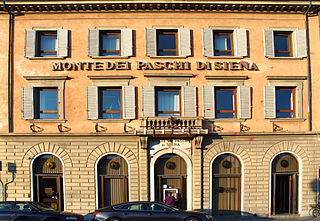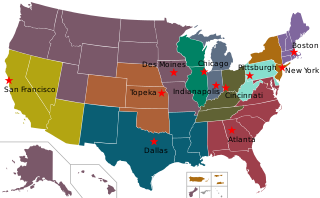Related Research Articles

The Federal Reserve System is the central banking system of the United States. It was created on December 23, 1913, with the enactment of the Federal Reserve Act, after a series of financial panics led to the desire for central control of the monetary system in order to alleviate financial crises. Over the years, events such as the Great Depression in the 1930s and the Great Recession during the 2000s have led to the expansion of the roles and responsibilities of the Federal Reserve System.
The Reconstruction Finance Corporation (RFC) was an independent agency of the United States federal government that served as a lender of last resort to US banks and businesses. Established in 1932 by the Hoover administration to restore public confidence in the economy and banking to their pre-Depression levels, the RFC provided financial support to state and local governments, recapitalized banks to prevent bank failures and stimulate lending, and made loans to railroads, mortgage associations, and other large businesses. The Roosevelt administration's New Deal reforms expanded the agency, enabling it to direct disaster relief funds and provide loans for agriculture, exports, and housing. The RFC closed in 1957 when prosperity had been restored and for-profit private financial institutions could handle its mission. In total, the RFC gave US$2 billion in aid to state and local governments and made many loans, nearly all of which were repaid.

The Federal Deposit Insurance Corporation (FDIC) is a United States government corporation supplying deposit insurance to depositors in American commercial banks and savings banks. The FDIC was created by the Banking Act of 1933, enacted during the Great Depression to restore trust in the American banking system. More than one-third of banks failed in the years before the FDIC's creation, and bank runs were common. The insurance limit was initially US$2,500 per ownership category, and this has been increased several times over the years. Since the enactment of the Dodd–Frank Wall Street Reform and Consumer Protection Act in 2010, the FDIC insures deposits in member banks up to $250,000 per ownership category. FDIC insurance is backed by the full faith and credit of the government of the United States, and according to the FDIC, "since its start in 1933 no depositor has ever lost a penny of FDIC-insured funds".

In the United States, banking had begun by the 1780s, along with the country's founding. It has developed into a highly influential and complex system of banking and financial services. Anchored by New York City and Wall Street, it is centered on various financial services, such as private banking, asset management, and deposit security.

A financial institution, sometimes called a banking institution, is a business entity that provides service as an intermediary for different types of financial monetary transactions. Broadly speaking, there are three major types of financial institution:
- Depository institution – deposit-taking institution that accepts and manages deposits and makes loans, including bank, building society, credit union, trust company, and mortgage broker;
- Contractual institution – insurance company and pension fund
- Investment institution – investment bank, underwriter, and other different types of financial entities managing investments.

Fractional-reserve banking is the system of banking in all countries worldwide, under which banks that take deposits from the public keep only part of their deposit liabilities in liquid assets as a reserve, typically lending the remainder to borrowers. Bank reserves are held as cash in the bank or as balances in the bank's account at the central bank. Fractional-reserve banking differs from the hypothetical alternative model, full-reserve banking, in which banks would keep all depositor funds on hand as reserves.

Financial services are economic services tied to finance provided by financial institutions. Financial services encompass a broad range of service sector activities, especially as concerns financial management and consumer finance.

The Community Reinvestment Act is a United States federal law designed to encourage commercial banks and savings associations to help meet the needs of borrowers in all segments of their communities, including low- and moderate-income neighborhoods. Congress passed the Act in 1977 to reduce discriminatory credit practices against low-income neighborhoods, a practice known as redlining.

The Federal Home Loan Banks are 11 U.S. government-sponsored banks that provide liquidity to financial institutions to support housing finance and community investment.
In banking and finance, clearing denotes all activities from the time a commitment is made for a transaction until it is settled. This process turns the promise of payment into the actual movement of money from one account to another. Clearing houses were formed to facilitate such transactions among banks.
A bailout is the provision of financial help to a corporation or country which otherwise would be on the brink of bankruptcy.
The Clearing House Interbank Payments System (CHIPS) is a United States private clearing house for large-value transactions. As of 2023, it settles approximately 500,000 payments totaling US$1.7 trillion per day. Together with the Federal Reserve Banks' Fedwire Funds Service, CHIPS forms the primary U.S. network for large-value domestic and international USD payments where it has a market share of around 96%. CHIPS transfers are governed by Article 4A of Uniform Commercial Code.

OneWest Bank, a division of First Citizens BancShares, was a regional bank with over 60 retail branches in Southern California. OneWest Bank specialized in consumer deposit and lending including personal checking and savings accounts, Money Market accounts, CDs, and home loan products. OneWest offered small business checking, savings, CD, and money market accounts as well as small business loans and treasury management products.

The American subprime mortgage crisis was a multinational financial crisis that occurred between 2007 and 2010 that contributed to the 2007–2008 global financial crisis. The crisis led to a severe economic recession, with millions of people losing their jobs and many businesses going bankrupt. The U.S. government intervened with a series of measures to stabilize the financial system, including the Troubled Asset Relief Program (TARP) and the American Recovery and Reinvestment Act (ARRA).
The subprime mortgage crisis impact timeline lists dates relevant to the creation of a United States housing bubble and the 2005 housing bubble burst and the subprime mortgage crisis which developed during 2007 and 2008. It includes United States enactment of government laws and regulations, as well as public and private actions which affected the housing industry and related banking and investment activity. It also notes details of important incidents in the United States, such as bankruptcies and takeovers, and information and statistics about relevant trends. For more information on reverberations of this crisis throughout the global financial system see 2007–2008 financial crisis.

A bank is a financial institution that accepts deposits from the public and creates a demand deposit while simultaneously making loans. Lending activities can be directly performed by the bank or indirectly through capital markets.
The Bank of New England Corporation was a regional banking institution based in Boston, Massachusetts, which was seized by the Federal Deposit Insurance Corporation (FDIC) in 1991 as a result of heavy losses in its loan portfolio and was placed into Chapter 7 liquidation. At the time, it was the 33rd largest bank in the United States, and its federal seizure bailout was the second-largest on record. At its peak, it had been the 18th largest bank and had over 470 branch offices. The liquidation company was named Recoll Management Corporation and its bankruptcy estate has continued to exist to pay out claims against the company. As of 2016, most of what was once Bank of New England is now part of Bank of America.
This article details the history of banking in the United States. Banking in the United States is regulated by both the federal and state governments.
Mortimer Norton Buckner was an American banker who served as president and chairman of the board of New York Trust Company, the New York Clearing House, and the National Credit Corporation.
References
- ↑ "Reconstruction Finance Corporation". EH.net Encyclopedia. Archived from the original on October 29, 2013.
- ↑ "Managing the Crisis: The FDIC and RTC Experience — Chronological Overview". fdic.gov. Federal Deposit Insurance Corporation. Retrieved March 15, 2024.
- ↑ "Mortimer N. Buckner" . The New York Times . 27 February 1942. Retrieved 25 August 2020.
- ↑ Times, Special to The New York (16 October 1931). "FIRST BENEFIT SEEN FROM BANKING POOL" . The New York Times . Retrieved 25 August 2020.
- 1 2 3 "BUCKNER PRAISES NEW DISCOUNT PLAN" . The New York Times . 5 December 1931. Retrieved 25 August 2020.
- ↑ "Bank Pool Is Ready to Start This Week; the Members of the National Credit Corporation at First Meeting" . The New York Times . 18 October 1931. Retrieved 25 August 2020.
- ↑ "TONE OF CONFIDENCE NOTED IN BUSINESS" . The New York Times . 18 October 1931. Retrieved 25 August 2020.
- ↑ "BANKING CHANGES ALLOWED" . The New York Times . 14 November 1931. Retrieved 25 August 2020.
- ↑ "BANK AID COMPANY CALLS $50,000,000" . The New York Times . 14 January 1932. Retrieved 25 August 2020.
- 1 2 "CREDIT BOARD CALLS THIRD $50,000,000" . The New York Times . 23 January 1932. Retrieved 25 August 2020.
- ↑ "National Credit Corporation Pays $20,250,000 of Notes" . The New York Times . 29 March 1932. Retrieved 25 August 2020.
- ↑ "National Credit Corporation To Cut Notes to $79,775,000" . The New York Times . 13 April 1932. Retrieved 25 August 2020.